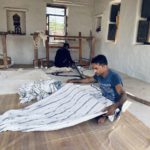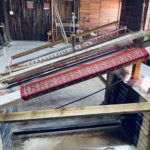Kutch and Bhuj have been home to weavers for centuries– for generations. The Bhujodi weave is different because it was traditionally done in wool, using a pit loom with natural dyes. Today, the geometric designs have attracted textile lovers who have pushed for converting these Bhujodi weaves into sarees. Bhujodi weavers have adapted to this change, and well.
Watch Vankar Dineshji-bhai Vishram give an introduction to the Bhujodi weave.
The prettiest village in Bhuj: Bhujodi
Bhujodi is arguably the prettiest village in Bhuj. There is a neat main street with shops lining either side. When I drove in, I saw a group of Rabari women in flowing black skirts and veils standing on the side of the street. These were the original consumers of the crafts that flowered in Bhuj.
Walking through the village, the visitor feels a sense of serenity and peace. Cowbells clink. The mud roads are clean. Fields and hills border the village. Mud houses give a feeling of connection to the earth. There are indigo fields in the back so that what you are wearing has low carbon impact.
Inside the houses are large courtyards where you can see the entire ecosystem in miniature. There are the cows, of course, with large limpid eyes and prominent humps. These are the khankrej breed: desi cows that are the lifeblood of dairy-rich Gujarat.
Balanced on the walls of homes are the pots– made with local clay and used for a variety of reasons including cooking, storing water and (in a different form) to create the earthenware vats in which indigo is mixed.
There are piles of hay– feed for the cattle. Sheds dot the boundaries so that weavers can take a break and sip some chai.
Vankar Vishram Valji
The first thing you see when you walk into the home of Vankar Vishram Valji in Bhujodi is a group of young men playing cricket. Weaving is tiring work, involving focus and concentration. Sometimes, you need to cool off with a game.
The late Vishram Valji’s four sons run the business now. The eldest, Shamji is the face of the business. He lives in Bhujodi with his brothers. They still work in the ancestral compound.
The home/office/worshop/shop is a hive of activity. Every now and then, a sadhu walks up to the gate to ask for alms. The matriarch of the house, Shamji’s mother walks by the courtyard and takes her place in the centre, so that she can keep an eye on the comings and goings.
In a corner shed, a small group of people are working on tassels, to finish the bhujodi weave.
How many hands make a Bhujodi?
In order to get a sense of the number of hands that work on the Bhujodi saree or shawl, you need to go into a tiny room in the back. Here, a man and woman (husband and wife?) are ironing the fabric before it goes on the shop floor. It is the last step in the beautification process. The fabric is cosseted and finished for the pleasure of the customers.
Watch the man discuss kala cotton below. Here, he is saying that kala cotton or organic cotton is used for bhujodi weaving. He says that the amount of spray of pesticides that is used in BT Cotton is very high. Whereas in kala cotton, there is very little chemical spraying. Therefore it is soft.





